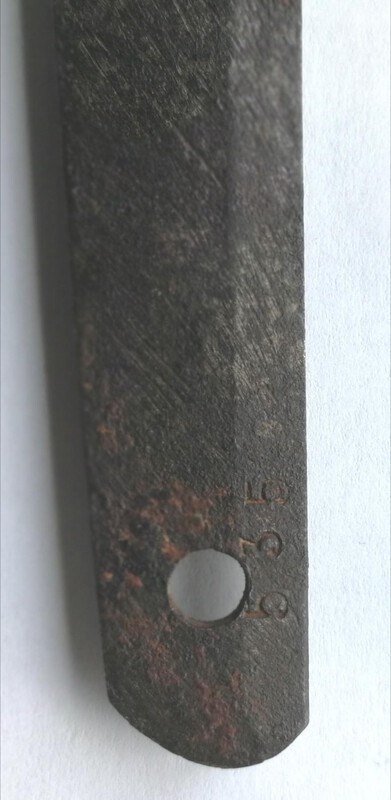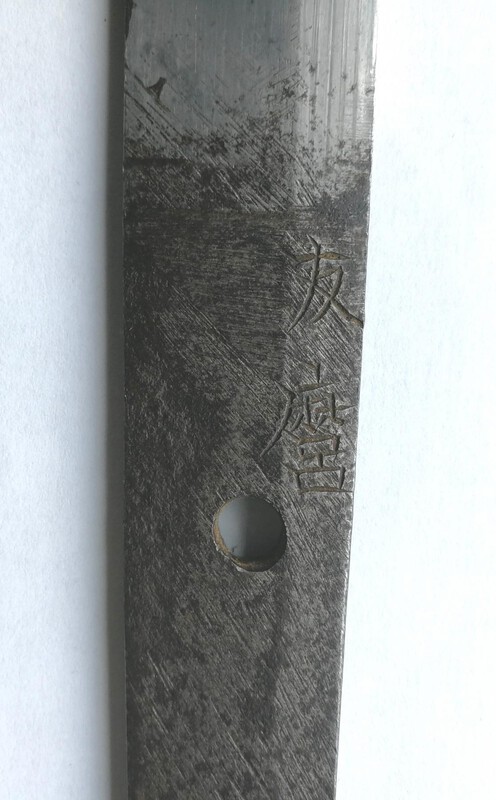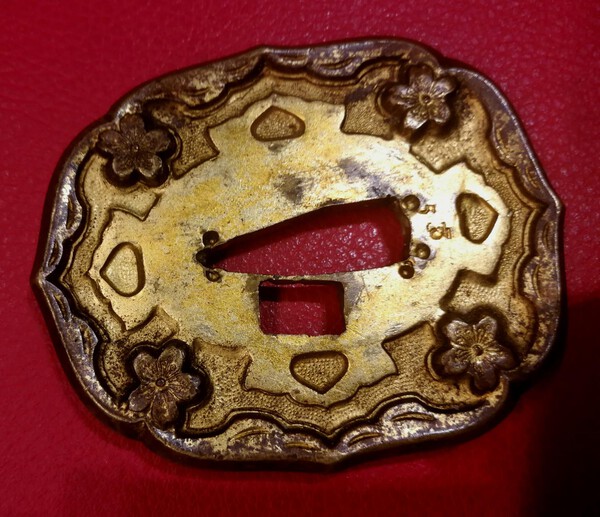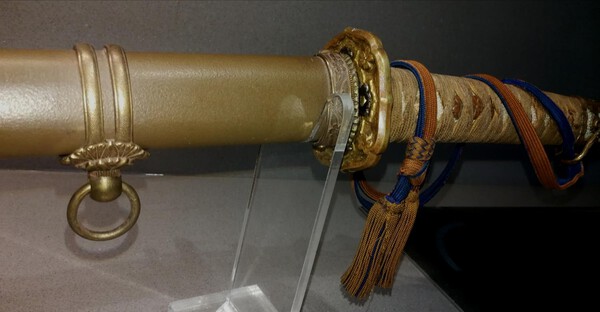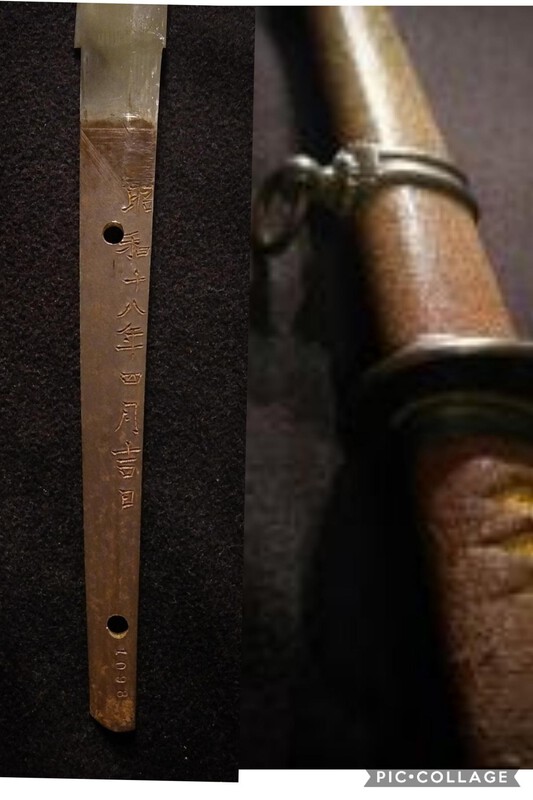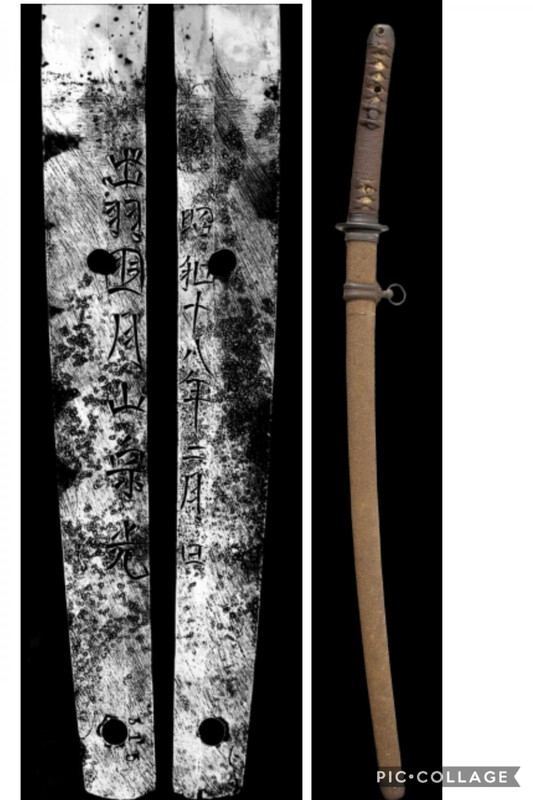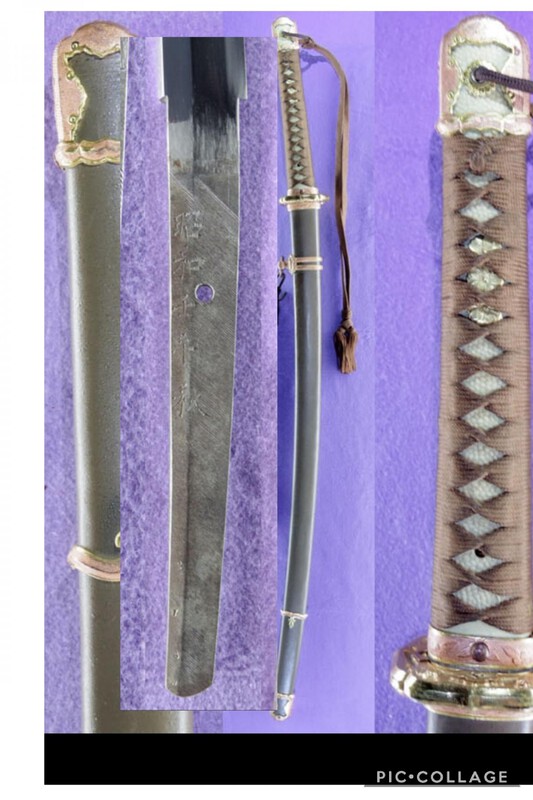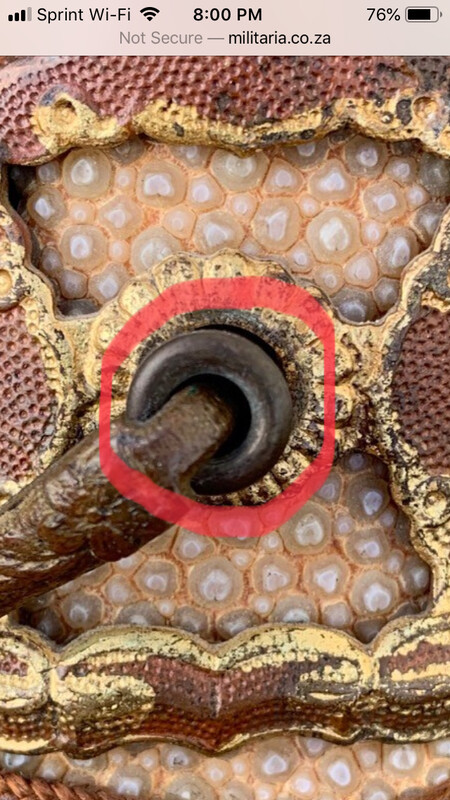-
Posts
12,994 -
Joined
-
Last visited
-
Days Won
155
Content Type
Profiles
Forums
Events
Store
Downloads
Gallery
Everything posted by Bruce Pennington
-

Need help.with translation gunto sword.
Bruce Pennington replied to Geoffry Persoon's topic in Translation Assistance
Thanks Geoffry, it confirms what I was thinking about the stamped number. They seem to be prefered by some fitters to painting numbers on the nakago. So far, the fittings are a bit higher quality than average that have the stamped numbers. You can see more examples here: http://www.militaria.co.za/nmb/topic/28883-koshirae-fitters-stamping-blades/ -

Koshirae Fitters Stamping Blades
Bruce Pennington replied to Bruce Pennington's topic in Military Swords of Japan
Another one from the Translation Assistance forum. This one by smith Tomomaro. I wonder if there was a thought by the koshirae makers that painting a number on the tang was lower quality work, and stamping a number is higher quality? -

Attention Mantetsu Owners: A Survey
Bruce Pennington replied to Bruce Pennington's topic in Military Swords of Japan
Do you mean the one dated Feb, 2019? -

Koa Isshin With Nthk Papers
Bruce Pennington replied to PNSSHOGUN's topic in Military Swords of Japan
Right. It's likely an effect of the language that gets thrown around constantly - "manchine made" vs "hand made". A hydraulic hammer is a machine. The more I heard these terms, the more my mind simply imprinted "machine invovled, then showato." I understand now, thanks. -

Need help.with translation gunto sword.
Bruce Pennington replied to Geoffry Persoon's topic in Translation Assistance
Geoffry, Do the fittings have the same "535" number stamped on them? Could we see a picture of the saya (scabbard) also? -

Help Identifying Sword (was told WWII?)
Bruce Pennington replied to coffeehound21's topic in Military Swords of Japan
Mark, Many family blades were donated to the war effort, or bought by the govt. These were fitted out in either army or navy fittings, but they usually kept all or most of the "civillian" tsuka (handle). The saya (scabbard) was usually a wooden one covered in leather. Your ashi (belt hanger) is of the style used under a leather cover, so this confirms it. The tsuba and seppa (handguard and spacers) are WWII navy. Some guys enjoy trying to refit a gunto to its original condition as much as possible. Others prefer to leave them as they are found. If you care to refit, there are guys who can rewrap the handle for you. Prices seem to be around $200 for that. Leather covers are findable, but the odds of getting one to fit perfectly are hit-and-miss. -

Koa Isshin With Nthk Papers
Bruce Pennington replied to PNSSHOGUN's topic in Military Swords of Japan
Well, Ok. For some reason, I had gotten it in my head that use of a machine, even if the steel was tamahagne, disqualified a blade as being nihonto for rating purposes. I reviewed Fuller's list of 9 methods and it doesn't actually say that. He uses the term "fully hand made" but even that term is open to variation - a sledgehammer isn't a "hand", it's a tool, as would a hydraulic hammer be a tool. "Traditional" might eliminate the hydraulic hammer. But then, the real source of the answer are the Shinsa organizations themselves. I personnaly feel the same as you all do, I simply had gotten it in my head from somewhere that nihonto had to be made with aprentices weilding hammers. So, actually, it's just tamahagane, water quenched. Thanks for clearing that up! -

Koa Isshin With Nthk Papers
Bruce Pennington replied to PNSSHOGUN's topic in Military Swords of Japan
Just watched a youtube documentary on a Japanese National Treasure smith named Kawachi - "Master and his last disciple". Toward the end, they get in touch with his #1 and #2 disciples. The #1, Takami, is using a hydraulic hammer to make his blades! How can his blades ever rate a paper considering the post-WWII rating system for "traditionally made" blades? Part of the documentary's discussion is the slow death of the swordsmith craft. Kawachi-san had 1, that's ONE disciple during filming. Takami, while they didn't discuss it on film, looked like he was working alone. How can a smith hope to make a "traditionally made" blade without apprentices to hammer and do other chores? I really do feel, as we've covered already, that it is time to revamp the rating criteria. But, hey, I'm no nihonto guy. -

Documentary Video on Returning WW2 Sword
Bruce Pennington replied to zook's topic in Military Swords of Japan
Jason, thanks for the recommendation! It was a really good education of how the katana is made. More complete than several of the videos I've seen so far. I'm very interested to hear what the Nihonto experts think of Kawachi's #1 disciple's use of a hydralic hammer to make his blades!!! How could his work ever be papered under the post-war rating system? This bears consideration - and is discussed on the thread where we are talking of WWII gunto getting papers: http://www.militaria.co.za/nmb/topic/28129-koa-isshin-with-nthk-papers/ -

Help with inherited Sword
Bruce Pennington replied to spidersrule123's topic in Translation Assistance
Ian, The Type 3, or contingency model, had a metal screw close to the tsuba (handguard) and a bamboo peg at the top end. It's fairly common for either one to be missing. You can get replacement pegs (mekugi) online for $3-4 USD. Some guys cut the end off a chopstick. The double-release buttons are an upgrade on the fittings and are mostly found when the blade is traditionally made. -

Koshirae Fitters Stamping Blades
Bruce Pennington replied to Bruce Pennington's topic in Military Swords of Japan
George, The Japaneseswordindex.com has the yama listed as: "Gunto Sei Saku Jo Located in Tokyo. The company was owned by Mr. Matsuyama. This firm made koshirae for both army and navy, as well as koshirae for police, diplomatic, and ceremonial uses." It seems too coincidental that the Matsu and yama are both parts of the owner's name. I wonder if the brothers were on contract with Matsuyama's shop for those 2 years (or vice versa). Do you know if they were RJT smiths the whole time, or maybe just started in '43? (my memory fails me as to the original start of the official RJT operation). -

Koshirae Fitters Stamping Blades
Bruce Pennington replied to Bruce Pennington's topic in Military Swords of Japan
I should note that George Trotter has already identified a numbering practice on nakago by the Yamagami Brothers on this thread: http://www.militaria.co.za/nmb/topic/8546-survey-of-gunto-contract-numbers/?hl=%2Byamagami+%2Bbrothers So, this thread isn't claiming that all numbers on nakago are done by fitters. And of course, we all know of the Mantetsu practice. If anyone else has examples of nakago stamped numbers matching koshirae, it would be good to document them here. Thanks! -
This discussion could go on the Arsenal Stamps thread, since it's strayed considerably from the titled topic, but there are some collectors that are quite interested in koshirae, so I think it deserves it's own thread. There are a number of blades that have alpha-numeric numbers stamped on the end of the nakago, and I've started this thread to document the practice, and where possible, identify the reasons for it. Posts by Ray Singer and Chris (Vajo) on the "Show Us Your High Class Gunto" thread (http://www.militaria.co.za/nmb/topic/18610-show-us-your-high-class-gunto/page-7) have revealed two gendaito made by two different smiths that are fitted with near identical, high-quality fittings, and both are stamped with numbers of similar style on the same location of the nakago. I've also recently come across a Mantetsu stamped in a similar way with a number that matches the numbers stamped on the tsuba and seppa. The fittings are high quality, though not the top-quality of Ray's and Chris' examples. The 3 indicate that the numbers on the blades were put there by the koshirae manufacturer/fitter and not by the smith. Ray's: Chris': Mantetsu:
-

Show Us Your High Class Gunto
Bruce Pennington replied to lonely panet's topic in Military Swords of Japan
Chris, Does your nakago have a number stamped at the end of it like Rays? I came across a Mantetsu with a number stamped on it like this and the number matched the number on the fittings, as if it was the koshirae maker that fitted out the blade who put the stamp on the nakago. -

1875/type 19 kyu gunto- real or fake?
Bruce Pennington replied to Pika007's topic in Military Swords of Japan
Ofek, Terminology in our collecting world is a bit of a mash-up. "Kyu-gunto" simply means "Old army sword" where "Shingunto" means "New army sword."! So using the terms of WWII, anything prior to the shingunto is a kyugunto. Dawson called the 2-ring 1875 version a Type 8; and the single-ring 1886 version a Type 19. So this one is the Type 19, kyugunto. Pics don't show the backstrap well, but it appears to be company grade. -

Documentary Video on Returning WW2 Sword
Bruce Pennington replied to zook's topic in Military Swords of Japan
Dan, I'd heard of this show for a couple of years, yet never watched it. I'm watching it now. So far quite enjoyable, thanks for sharing. I've enjoyed the healing aspect of such acts. Like the V.N. Air Force pilots that have gone back and met V.N. pilots and their families and have become dear friends. -
Tom, Good call on not forcing it off. I have a Koto era blade with a fat nakago. The fitters actually put the nakago on wide and tapped it down once in place to snug it up. It won’t come off now, either.
-
It is a good reminder (especially for guys like me!). Quite a beautiful blade! These older blades continue to amaze me that they maintain their shine and beauty for hundreds of years.
-
Neil, my thinking too. And we all face this in this hobby. If the OP was selling, then his story would easily fall into that category - trust the blade, not the story. But if he's just a guy with his dad's sword, and wants to learn about it, I would give him the benefit of the doubt. In the end, only the sword knows!!! Ha!
-

Koa Isshin With Nthk Papers
Bruce Pennington replied to PNSSHOGUN's topic in Military Swords of Japan
I love it!!! Ha! And using the Japanese practice of creating a shorter name, taking the first syllable and last, combined .... we have ni-to! neeto, get it?! -
Ok, Tom, we'll wait for your pics. I'll say up front, I'm no nihonto expert, nor a age/era one either. But look at the cross-section of this hole. That rust layer is THICK. The 3 holes on an old blade simply tell that it was refitted that many times over it's life, which is not unusual. That one offset is really odd, but the strange reshaping of the nakago may go along with that part of the story. Odd though. Tom - on the barrel screw, the picture you showed is the male side. It should screw into the female side of the other half on the other side of the kabutogane. Is there another half? On the green stuff, is it rust, or glue of some sort? I use a steel sanding sponge. It looks like a plastic sponge, but it's made to sand steel. You can very carefully work the specific area of the green stuff. When you put it back together, the order is simply dictated by size. The larger pieces are against the tsuba, and size down as you go, on both sides. I would keep the leather one because it goes with the saya. I wouldn't be bothered by the mismatch. Like someone said above, things get loose over time, and whether on the battlefield or post-war, seppa get added to tighten the fit. I've added some to a couple of mine that were missing seppa. I've got some spares I could mail you, if you like. Use what fits, then mail the rest back to me. PM me if you want to try it. These family blades were donated and/or bought by the thousands throughout the war. Newpaper articles went out to the public asking for donated swords. Govt orders were sent out specifying size and pricing. It doesn't surprise me that some may not get a high-quality refit for the war. There are many gunto circulating today, that have been thrown together by a collector or seller. And like Dave said, some G.I.s grabbed blades w/o saya, and searched until they found a saya that fit well enough. But, bearing in mind your father's story, I see no other explanation than poor war-refit, or battlefield repair.
-
DON’T clean the rust off the nakago. It’s one of the primary ways of judging age. I’d clean the green stuff off the tsuba, but be careful to only affect the green. I found out the hard way that the tsuba and seppa have colorations that come off very easily. You don’t want to lose that. I think there probably was some kanji where the end if the nakago is, but has been cut off when the nakago was shortened. Cool blade and agree with John, quite old.
-
Nice move, Tom! Now we wait!
-
Quite peculiar! Two options: 1. Grab the tsuba on both sides with both hands and rock the tsuba . I have dislodged stuck tsukas that way. 2. The barrel screw at the top unscrews. If it is through a hole in the nakago, removing it will free the tsuka. You will have to bend the sarute enough to get it off first. To have a hole that high is unusual for this type blade, common in Type 3, or contengency, blades. I would try it though.
-
Quite peculiar! Two options: 1. Grab the tsuba on both sides with both hands and rock the tsuba . I have dislodged stuck tsukas that way. 2. The barrel screw at the top unscrews. If it is through a hole in the nakago, removing it will free the tsuka. You will have to bend the sarute enough to get it off first. To have a hole that high is unusual for this type blade, common in Type 3, or contengency, blades. I would try it though.


